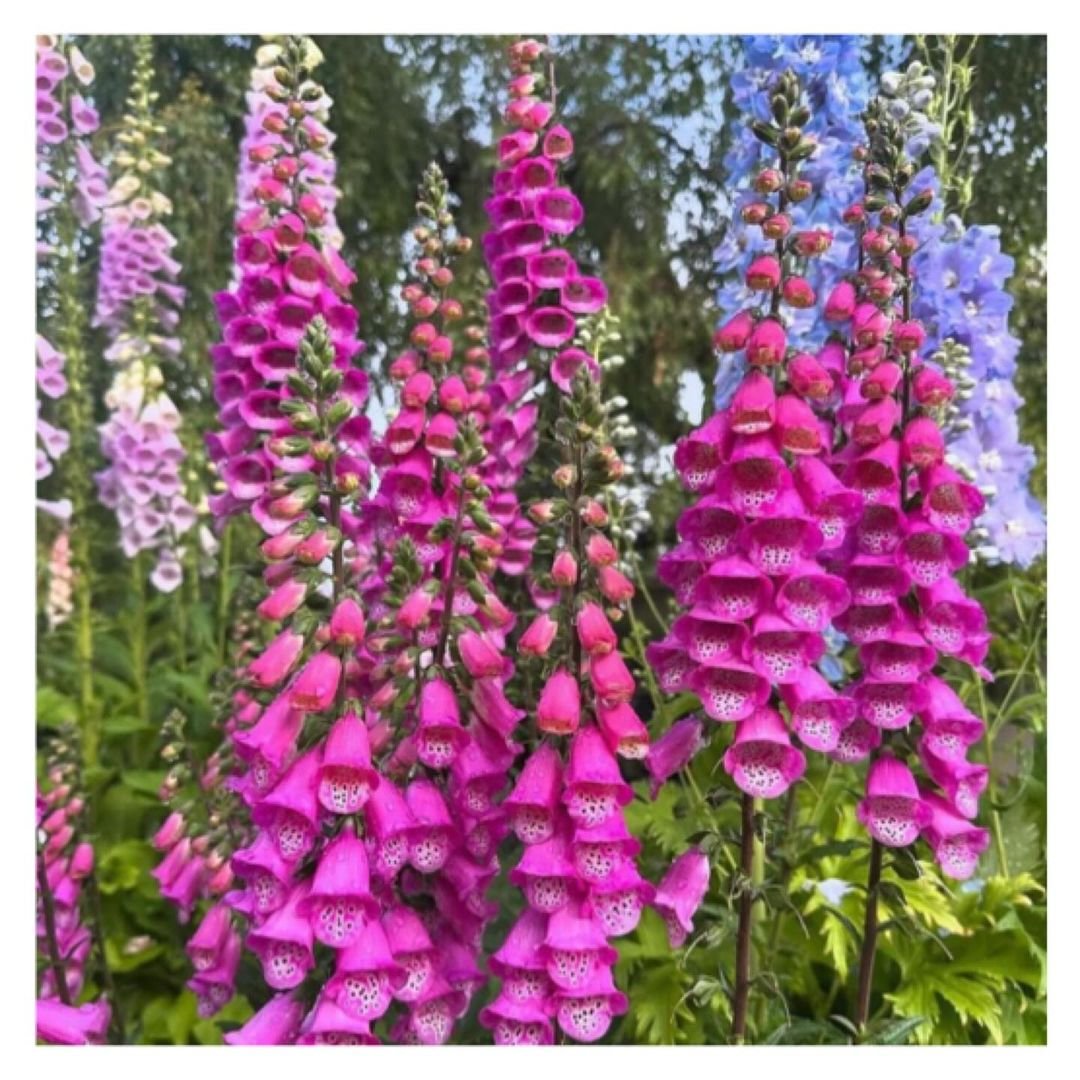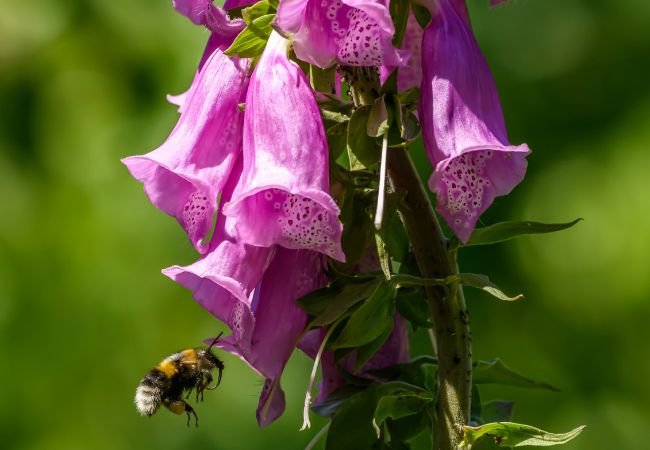Delve into the delicate charm of Foxglove flowers with our comprehensive guide. Explore their beauty, unique characteristics and how these stunning blooms add enchantment to natural landscapes.
Foxglove flowers are beautiful plants that catch your eye. They grow tall and have many small flowers on one stem. These flowers look like little bells or trumpets. Foxgloves come in many colors, like pink, purple, white and yellow. Let’s learn more about these pretty plants.
Here’s a chart with information about Foxglove flowers:
| Category | Information |
|---|---|
| Botanical Name | Digitalis purpurea |
| Common Name | Foxglove |
| Plant Type | Biennial or short-lived perennial |
| Hardiness Zone | USDA Zones 4-10 |
| Sun Exposure | Full sun to partial shade |
| Soil Type | Well-draining, fertile, slightly acidic soil |
| Watering | Moderate; prefers evenly moist soil |
| Growth Habit | Upright, tall flower spikes |
| Height/Spread | 2-5 feet tall, 1-2 feet wide |
| Special Features | Tall spikes of tubular flowers, attracts pollinators, toxic if ingested |
What Are Foxglove Flowers?

Foxglove flowers are part of the plant family called Plantaginaceae. Their scientific name is Digitalis. This name comes from the Latin word “digitus,” which means finger. The flowers look a bit like finger holes in a glove.
Foxgloves grow in many places. You can find them in Europe, Asia and North America. They like cool weather and grow well in shady areas. Foxgloves can grow very tall, sometimes up to 5 feet high!
How Foxgloves Got Their Name
The name “foxglove” is interesting. Some people say it comes from an old story. The story says that foxes wore these flowers on their paws to sneak around quietly. Of course, this isn’t true, but it’s a fun idea!
Others think the name comes from “folk’s glove.” In old times, “folk” meant fairies. People thought these flowers were magical and that fairies lived in them.
Types of Foxglove Flowers
There are many types of foxgloves. Here are some common ones:
- Common Foxglove (Digitalis purpurea): This is the most known type. It has purple or pink flowers.
- Yellow Foxglove (Digitalis grandiflora): As the name says, this one has yellow flowers.
- Rusty Foxglove (Digitalis ferruginea): This type has rusty brown or orange flowers.
- Straw Foxglove (Digitalis lutea): This foxglove has pale yellow flowers.
- Woolly Foxglove (Digitalis lanata): This one has small flowers with brown veins.
Each type of foxglove is special in its own way. They all add beauty to gardens and wild areas.
How Foxgloves Grow
Foxgloves are biennial plants. This means they live for two years. In the first year, they grow leaves close to the ground. These leaves are big and green. In the second year, the plant grows tall and makes flowers.
Foxgloves bloom in late spring or early summer. The flowers grow on one side of the stem. They open from the bottom up. This makes the plant look very pretty as more flowers open each day.
After flowering, foxgloves make seeds. These seeds fall to the ground and grow into new plants. This is how foxgloves spread in nature.
Where Foxgloves Like to Grow
Foxgloves like cool places. They grow well in areas with some shade. You can find them in:
- Woodlands
- Forest edges
- Gardens
- Along fences
- In wild meadows
These plants like soil that drains well. They don’t like to have wet feet! Foxgloves can grow in many types of soil, but they prefer soil that’s a bit acidic.
Colors of Foxglove Flowers
Foxgloves come in many pretty colors. The most common colors are:
- Pink
- Purple
- White
- Yellow
- Cream
Some foxgloves have spots inside the flowers. These spots can be darker or lighter than the main color. The spots guide bees into the flower to help with pollination.
How Bees Help Foxgloves
Bees love foxglove flowers. The flowers are shaped just right for bees to crawl inside. When a bee goes into a foxglove flower, it gets covered in pollen. Then, when it goes to another flower, it spreads this pollen.
This process is called pollination. It’s how foxgloves make seeds to grow new plants. Without bees, foxgloves would have a hard time making new plants.
Foxgloves in Gardens
Many people like to grow foxgloves in their gardens. They’re easy to grow and look very pretty. Here are some tips for growing foxgloves:
- Plant them in spring or fall.
- Choose a spot with some shade.
- Make sure the soil drains well.
- Water them regularly, but don’t let the soil get too wet.
- After they flower, let some seeds fall to grow new plants.
Foxgloves look great in cottage gardens. They also work well in wild garden areas. You can plant them with other flowers that like shade, like hostas or ferns.
Foxgloves in History and Culture
Foxgloves have been known for a long time. In old stories, people thought they had magic powers. Some believed foxgloves could protect you from evil spirits.
In the past, people also used foxgloves as medicine. They didn’t know it was dangerous to eat these plants. Today, we know better. We only use foxgloves to make special heart medicine in safe ways.
Foxgloves appear in many old paintings and stories. They often represent both beauty and danger. This is because the plants are pretty but can be harmful if eaten.
Interesting Facts About Foxgloves
Here are some cool things to know about foxgloves:
- Foxgloves can grow over 5 feet tall!
- Each foxglove plant can have up to 80 flowers.
- The flowers grow on only one side of the stem.
- Foxgloves are related to snapdragons.
- They make a special medicine for heart problems.
- Foxgloves can live in the wild for many years by making new plants from seeds.
How Foxgloves Help Nature
Foxgloves are good for nature in many ways:
- They provide food for bees and other insects.
- Their seeds feed small birds.
- They help hold soil in place with their roots.
- Foxgloves add beauty to wild areas.
By growing in woodlands and meadows, foxgloves help keep these places healthy and full of life.
Growing Foxgloves from Seeds
You can grow your own foxgloves from seeds. Here’s how:
- Sprinkle seeds on top of soil in small pots.
- Don’t cover the seeds. They need light to grow.
- Keep the soil damp but not too wet.
- Seeds will sprout in about 2-3 weeks.
- When plants are big enough, move them to your garden.
Growing foxgloves from seeds is fun and easy. It’s a great way to get many plants for free!
Caring for Foxgloves
To keep your foxgloves healthy:
- Water them when the soil feels dry.
- Remove dead flowers to encourage more blooms.
- Support tall plants with stakes if needed.
- Cut down old stems in fall.
- Protect young plants from slugs and snails.
With good care, your foxgloves will bloom beautifully year after year.
Using Foxgloves in Flower Arrangements
Foxgloves make lovely cut flowers. Their tall stems look great in vases. Here are some tips:
- Cut stems early in the morning.
- Put them in water right away.
- Remove leaves that will be underwater.
- Change the water every few days.
- Enjoy your beautiful foxglove arrangement!
Remember, always wear gloves when handling foxgloves. This keeps you safe and protects the plants too.
Foxgloves in Different Seasons
Foxgloves change through the year:
- Spring: New leaves grow.
- Early Summer: Tall flower stems appear.
- Mid-Summer: Flowers bloom from bottom to top.
- Late Summer: Seeds form.
- Fall: Plants die back, leaving seeds for next year.
- Winter: Seeds wait in the soil for spring.
This cycle helps foxgloves come back year after year in gardens and wild places.
Foxglove flowers are truly special plants. They bring beauty to gardens and wild areas. Their tall stems and bell-shaped flowers catch our eye and make us smile. Foxgloves help nature by feeding bees and birds. They also have an interesting history in stories and medicine.
Whether you see foxgloves in a garden or in the woods, take a moment to enjoy their charm. Watch bees buzz in and out of the flowers. Notice how the colors brighten up shady spots. Foxgloves remind us of the wonder and beauty in nature.
Remember, while foxgloves are pretty to look at, we should be careful around them. Don’t eat any part of the plant. But do enjoy their beauty and the life they bring to our world.
Foxgloves show us how something can be both delicate and strong. They grow tall from tiny seeds. They come back year after year. In their own quiet way, foxgloves make our world a bit more magical.
Next time you see a foxglove, think about all you’ve learned. These flowers have so much to tell us about nature, beauty, and the changing seasons. Foxgloves truly are one of nature’s delicate charms.








Leave a Reply